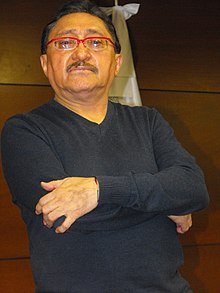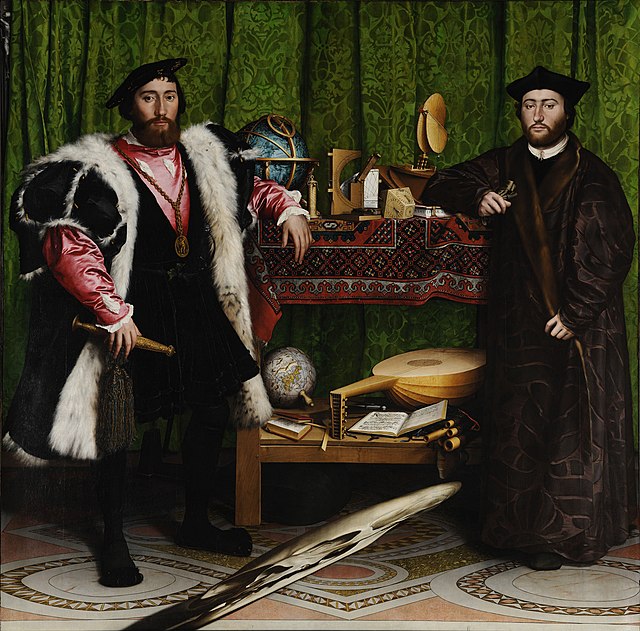Loading AI tools
Mexican journalist (1950-2017) From Wikipedia, the free encyclopedia
Sergio González Rodríguez (26 January 1950 – 3 April 2017)[1] was a Mexican journalist and writer who was best known for his works on the femicides in Ciudad Juárez from the 1990s to the 2000s, such as Huesos en el desierto (Bones in the Desert) and The Femicide Machine. González Rodríguez was a writer who worked in many literary genres, producing literary journalism or crónicas [es], novels, essays, and screenplays for documentaries. His writing was recognized with several awards in Mexico and Spain.
Sergio González Rodríguez | |
|---|---|
 González Rodríguez at Tec de Monterrey, Mexico City | |
| Born | 26 January 1950 Mexico City |
| Died | 3 April 2017 (aged 67) Mexico City |
| Occupation | Journalist, critic, essayist and screenwriter |
| Language | Spanish |
| Alma mater | National Autonomous University of Mexico |
| Years active | 1993–2017 |
| Notable works | Bones in the Desert, The Headless Man, The Femicide Machine, The Iguala 43, Field of Battle |
| Notable awards | Fernando Benítez National Journalism Prize (1995) |
González Rodríguez was born in Mexico City in 1950.[2] His mother died while he was in the third grade and his father abandoned his family, forming another family.[3] González Rodríguez studied modern literature at the National Autonomous University of Mexico from 1978 to 1982.[1][4] Apart from his writing career he was a rock musician, playing bass with some of his brothers in a band named Enigma.[3][4]
Following the publication of Huesos en el desierto, González Rodríguez was kidnapped via taxi and beaten by assailants who warned him that his work was being "closely monitored"; he suffered a cerebral hemorrhage and survived the attack, continuing his journalistic work.[5]
González Rodríguez died in hospital on 3 April 2017 from a heart attack.[6]
González Rodríguez made his career as a critic, narrator, essayist, literary historian and scriptwriter.[1][4]
After graduating, he worked at the Historical Studies Department of the Instituto Nacional de Antropología e Historia from 1985 to 1988. From 1990 to 1992, he was an assistant of the Exhibition Coordination of CONACULTA, working on a multimedia production called "Asamblea de ciudades, la Ciudad de México 1920–1950". His work in journalism includes editing at the Estudio de Salvador Novo A.C. and at the Biblioteca de México magazine from 1993 to 2000, as well as serving as editor and photographer at the Luna Córnea magazine from 1992 to 2002.[1] When the Reforma newspaper was founded in 1993, he joined as editor and columnist for both the regular paper and its cultural supplement, called El Ángel. He has also worked for La Jornada.[1][7][8]
González Rodríguez was best known for his investigative work about the femicides in Ciudad Juárez in the 1990s and 2000s.[7][9] He began as an investigative reporter, making his first trip to the area in 1995 for Reforma. His series of articles served as the basis for the book Huesos en el desierto (Bones in the Desert), published in 2002, which mixes reporting, essay and reflective writing.[8] This work was a finalist at the Lettre Ulysses International Prize of Literary Reporting in Germany and was translated into Italian and French.[4] It influenced other writing on the topic, including a direct collaboration with writer Roberto Bolaño, who was writing the novel 2666 in the early 2000s as well.[9] González Rodríguez blamed the murders of the women on machismo and misogyny in Mexico.[9] This examination of violence led to two other books that form a trilogy on modern violence, El hombre sin cabeza (The Headless Man) and Campo de guerra (Field of Battle) which examine drug-related violence and the role of international politics, respectively.[2][10]
As a screenwriter, he wrote for the television series México, Siglo XX, and a documentary called Nacional Dominical which he also directed with Roberto Diego Ortega.[1] In 1993 his script for the documentary Los bajos fondos, produced by UNAM, won first prize at the third Festival y Muestra Nacional de Televisión y Video at the Instituciones de Enseñanza Superior en México.[1]
He worked as a professor at the Doctor José María Luis Mora Research Center.[1]
González Rodríguez wrote or co-wrote over twenty books,[lower-alpha 1] also contributing to the Anales de Literature Hispanoamericana of Universidad Complutense, Biblioteca de México, El Nacional Dominical, Ínsula (Spain), a supplement of the Siempre! magazine called La Cultura en México, La Jornada Semanal, Letras Libres, Nexos, and the Revista Universidad de México.[1]
His novels included El triángulo imperfecto (2003), El plan Schreber (2004), La pandilla cósmica (2005) and El vuelo (2008).[4] In 2014, he published a novel called El artista adolescente que confundía el mundo con un cómic, which integrated elements of graphic novels and comics into both the literary style and the storyline.[12] Other titles included the essays Los bajos fondos, el antro, la bohemia y el café (1988), El Centauro en el paisaje (1992),[8] De sangre y de sol (2006)[4] and El hombre sin cabeza.[4] He also edited Viajes y ensayos by Salvador Novo (1997).[1]
González Rodríguez wrote three closely related works of non-fiction which examine crime, corruption and the Drug War in Mexico: The Femicide Machine,[13][14] The Iguala 43 (Los 43 de Iguala)[15][16][17] and Field of Battle (Campo de guerra).[18][19][20] The latter two books were originally published in Spanish by Anagrama, and all three books were translated into English and published as entries in the Semiotext(e) Intervention Series. González Rodríguez wrote The Femicide Machine specifically for the Intervention Series;[14] although it is a distinct text from the longer Huesos en el desierto, both books examine the female homicides in Ciudad Juárez.
The three works are examples of crónicas [es], the Spanish word for a genre of literary journalism which blends straight reporting and editorializing.[lower-alpha 1]
In The Femicide Machine, González Rodríguez examines a series of circumstances which he argues have conspired to produce Ciudad Juárez' female homicide victims. Although violence associated with Mexico's illegal drug trade is one factor, he also considers the city's proximity to the U.S. border, its cultural and geographic separation from the rest of Mexico, historical prevalence of technology in the city (particularly cars and cell phones)[21] and the impact of NAFTA which incentivized the growth of maquiladoras along the border. These factories provided employment opportunities for women; according to González Rodríguez, this provoked a misogynistic resentment in Mexico's culture of machismo.[lower-alpha 2] In González Rodríguez' account, the confluence of these factors gave rise to a process which resulted in Ciudad Juárez' high rate of female murder victims; the process itself can be likened to a machine.
The text concludes with an account of the 2001 kidnapping and murder of Lilia Alejandra García Andrade, a factory worker and resident of Ciudad Juárez; following the murder, her mother Norma Andrade began activism against female homicide in Ciudad Juárez, and was herself attacked.[23]
The Iguala 43 examines the kidnapping of 43 male students in Iguala, Guerrero, Mexico, which ended with their presumptive murders. As in The Femicide Machine, González Rodríguez considers a series of historical circumstances which informed the tragedy—this time affecting male victims in Mexico's south, as opposed to female victims in its north.
On 26 September 2014, a group of male students from the Ayotzinapa Rural Teachers' College commandeered two local buses which they drove to nearby Iguala, where they took another three. Their plan was to travel to Mexico City to participate in protests commemorating the 1968 Tlatelolco massacre, after which they would return the buses.[24] In one account of following events, local police attacked the students, killing some, and then apprehended the survivors, turning them over to the Guerreros Unidos, a local criminal drug trafficking organization. The Guerreros Unidos then killed the surviving students and burned their bodies, disposing of the remains.[25]
González Rodríguez explains the historical circumstances which led to the atrocity. Located in Mexico's south, the Ayotzinapa Rural Teachers' college has a far-left political tradition, producing alumni such as Lucio Cabañas and Genaro Vázquez Rojas[26] who subsequently became guerrillas opposed to the Mexican state; a historical antagonism between Mexican authorities and Ayotzinapa personnel was formed. Further, there was an existing tradition of the forced disappearance and killing of activists; González Rodríguez cites the case of Rosendo Radilla, an activist who was stopped at a military checkpoint in 1974 and never seen again.[27] Taken together with the overall societal corruption and increased violence during the Mexican Drug War, González Rodríguez assigns blame for the massacre jointly to the governments of Mexico and the United States, on account of internal corruption and ongoing CIA operations within Mexico, respectively.[28]

In Field of Battle, González Rodríguez examines the contemporary militarization of Mexican society in response to drug-related violence. The central argument of the book is that the de facto absence of the rule of law is the root cause for ongoing violent crime and suffering within Mexico. This absence of the rule of law is generated by corruption which begins by eroding the legitimacy of the rule of law itself, and which ends by creating an "a-legal" world[30] in which the distinction between legality and illegality becomes meaningless because crimes are rarely punished[lower-alpha 3] and law enforcement themselves often do not enforce or respect the law. Given these circumstances, González Rodríguez uses the visual phenomenon of anamorphosis as a metaphor to describe the subjectively distorted reality experienced by victims of violent crime in Mexico who are often caught between police corruption, an inefficient legal system, and the violence of gangs or drug cartels.
The humanity of a person is objectified and reduced to their usefulness or uselessness for criminal activities, or to collateral damage on the part of the armed forces. The life world for those subjected to criminal domination or to the fight against crime tends to be emptied out and replaced with impositions, rules and the whims of criminals. Without this emptiness, there would be no anamorphosis of the victims, who glimpse a threat from their first contact—whether direct or indirect—with organized crime or government authority.
— Field of Battle, p. 104.
González Rodríguez concludes the text by advocating nonviolence and respect for the rule of law as antidotes both to drug violence and also to the militarization of Mexican society because unlike the latter, the former represent peaceful means which are consistent with their peaceful end.[lower-alpha 4]
Most of the passages from The Femicide Machine's third chapter War City/Mexico-USA are recycled throughout Field of Battle. In particular, the fourth chapter of Field of Battle, Global War on Drug Trafficking, rephrases and slightly permutes the latter two-thirds of War City/Mexico-USA.[lower-alpha 5] In both cases the material covers the geopolitical interests of the United States via CIA operations within Mexico and Latin America, and the expansion of Mexican drug trafficking to Europe via West Africa.
In 1993, González Rodríguez was a finalist at the Anagrama Essay Prize in Barcelona, Spain, with the work El centauro en el paisaje.[1][8] This was followed in 1995 by the Fernando Benítez National Journalism Prize in Mexico for Mujer de table-dance.[1][35]
The work Huesos en el desierto was a finalist at the Lettre Ulysses International Prize of Literary Reporting in Germany and received the Herralde Novel Prize in 2004.[1][4]
El triángulo imperfecto (2003) was a finalist of the Antonin Artaud Prize for novels in Mexico.[8]
In 2013, he won the Premio Casa América Catalunya a la Libertad de Expresión en Iberoamérica,[2][7] followed by the Anagrama Essay Prize for Campo de guerra in 2014.[10][36]
González Rodríguez' work was supported by grants from FONCA (1990–1991), two from the Rockefeller Foundation and from the history department of the Universidad Iberoamericana (1990–1999) .[1][4]
He was a member of the Sistema Nacional de Creadores de Arte of Mexico since 1996.[1][8]
Seamless Wikipedia browsing. On steroids.
Every time you click a link to Wikipedia, Wiktionary or Wikiquote in your browser's search results, it will show the modern Wikiwand interface.
Wikiwand extension is a five stars, simple, with minimum permission required to keep your browsing private, safe and transparent.